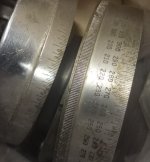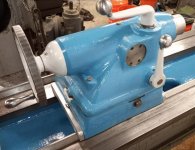texasgeartrain
Titanium
- Joined
- Feb 23, 2016
- Location
- Houston, TX
I have a Monarch 61 from 1956 that I'd like to have the dials re-plated. However the etching of graduates and numbers seems thin. I'm not sure if the marking were done prior to plating or after plating. Concern being that the markings will be washed out or not visible after getting plated.
I'm not at all familiar with chrome plating other than what I read up on in the past few days. Perhaps the plating is a much thinner coat than I realize, or maybe attemping to clean and polish is a better route, or maybe even dial replacement.
Any thoughts or advice appreciated.
Tried taking pics flash and no flash, so some pics may seem redundant.




I'm not at all familiar with chrome plating other than what I read up on in the past few days. Perhaps the plating is a much thinner coat than I realize, or maybe attemping to clean and polish is a better route, or maybe even dial replacement.
Any thoughts or advice appreciated.
Tried taking pics flash and no flash, so some pics may seem redundant.






 )
)




 . Getting different perspectives is a way I learn something.
. Getting different perspectives is a way I learn something.